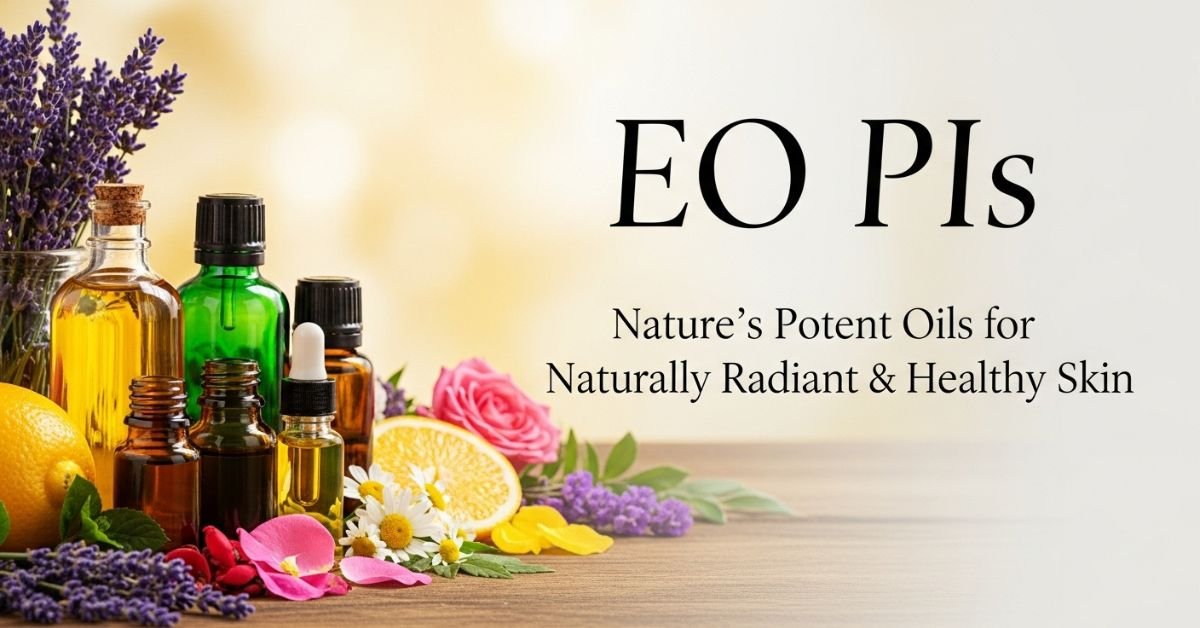EO PIs: Nature’s Potent Oils for Naturally Radiant & Healthy Skin
Contents
Introduction to EO PIs
Nature has given us countless treasures, but few are as versatile and powerful as essential oils. These natural plant extracts—often called EO PIs (Essential Oil Plant Infusions)—have been cherished for centuries for their ability to nourish, protect, and rejuvenate skin. In a world where many beauty products are loaded with synthetic ingredients, essential oils offer a pure and effective alternative.
The rise in interest for clean beauty has brought EO PIs back into the spotlight. Whether you struggle with dryness, dullness, or uneven skin tone, there’s likely an oil that can help. These natural extracts are rich in nutrients, antioxidants, and therapeutic qualities that can help soothe inflamed skin and give it a more youthful look.
This guide will take you deep into the world of EO PIs for skin care—how they work, which ones are best for different skin types, and how to use them safely for maximum results. By the end, you’ll be equipped with both knowledge and confidence to integrate these oils into your daily routine.
Why EO PIs Are a Skincare Game-Changer
Essential oils aren’t just about fragrance—they’re concentrated plant extracts containing the active compounds that give plants their healing properties. Because of this, even in tiny doses, they are extremely powerful and efficient.
Packed with Skin-Loving Nutrients
EO PIs are rich in vitamins, fatty acids, and antioxidants. These compounds help fight free radicals (which cause skin aging), boost cell regeneration, and keep skin looking youthful. For example, rosehip oil is a source of vitamin A (natural retinol), while jojoba oil closely mimics the skin’s own sebum.
Natural Solutions for Skin Concerns
Whether you have acne-prone, dry, sensitive, or mature skin, there’s an essential oil that can target your specific needs. Tea tree oil, for instance, has antibacterial properties perfect for acne, while chamomile oil soothes irritation.
Gentle but Effective
Unlike harsh chemical treatments, EO PIs work in harmony with your skin. When diluted properly, they support skin health without stripping its natural barrier. This makes them suitable for long-term use in your beauty regimen.
Top EO PIs for Glowing, Healthy Skin
1. Rosehip Oil – The Natural Retinol
Rosehip oil is often called a miracle oil for its ability to reduce scars, fine lines, and pigmentation. It is rich in vital fatty acids, vitamin C, and vitamin A. Regular use improves skin tone, promotes elasticity, and gives a subtle glow.
Best for: Mature skin, pigmentation, scars.
Tip: Apply 2–3 drops to clean, damp skin before moisturizer at night.
2. Jojoba Oil – The Balancing Act
Jojoba oil is structurally similar to human sebum, meaning it absorbs easily without clogging pores. It is ideal for both dry and oily skin types because it balances oil production.
Best for: All skin types, especially combination skin.
Tip: Use as a lightweight daytime moisturizer or as a makeup remover.
3. Tea Tree Oil – The Acne Fighter
Known for its antibacterial and anti-inflammatory properties, tea tree oil helps reduce acne-causing bacteria and soothes redness.
Best for: Oily, acne-prone skin.
Tip: Always dilute with a carrier oil before applying to avoid irritation.
4. Lavender Oil – The Skin Soother
Lavender oil calms irritated skin, reduces redness, and helps with minor wounds or burns. Its relaxing scent also promotes better sleep, indirectly supporting skin repair.
Best for: Sensitive, stressed skin.
Tip: Add a drop to your night cream for extra calming benefits.
5. Argan Oil – The Vitamin E Boost
Often called ‘liquid gold,’ argan oil is rich in vitamin E and omega fatty acids. It hydrates deeply while improving skin elasticity.
Best for: Dry, dull skin.
Tip: Use a few drops after your serum to lock in moisture.
How to Use EO PIs Safely for Skin
Essential oils are highly concentrated, so safety is crucial.
Dilution is Key
Never apply pure essential oil directly to skin (except in rare cases like lavender or tea tree in very small amounts). Make use of a carrier oil, like coconut, almond, or jojoba.
Recommended ratio: 2–3 drops of EO per teaspoon of carrier oil.
Patch Test Before Full Use
Test on a small area of skin to check for allergic reactions before using on your face.
Avoid Sensitive Areas
Keep oils away from the eyes, inside of the nose, and mucous membranes.
Creating a Simple EO PI Skincare Routine
Using EO PIs in a skincare routine doesn’t have to be difficult. Here’s an example:
Morning:
- Gentle cleanser
- Hydrating toner
- Serum with 2–3 drops of rosehip or jojoba oil
- Sunscreen
Night:
- Oil-based cleanser (jojoba or argan oil)
- Toner
- Targeted treatment (tea tree blend for acne or lavender for soothing)
- Moisturizer with a few drops of argan or rosehip oil
Myths & Misconceptions About EO PIs
Some people hesitate to use oils on their skin due to myths like “oils clog pores” or “oils cause breakouts.” In reality, the right oil, used correctly, can balance and improve skin health. Many oils are non-comedogenic, meaning they won’t clog pores at all.
Actionable FAQs – Targeting “People Also Ask”
What is the best essential oil for skin that glows?
Rosehip and argan oil are excellent choices. Rosehip boosts cell renewal, while argan deeply hydrates for a radiant glow.
Can sensitive skin be treated with essential oils?
Yes, but always dilute and start with gentle oils like lavender or chamomile. Avoid strong oils like peppermint unless heavily diluted.
How often should I use EO PIs on my face?
2–3 times per week for potent oils, but lighter oils like jojoba can be used daily.
Are EO PIs safe during pregnancy?
Some oils should be avoided during pregnancy. Always consult a healthcare professional before use.
Do essential oils replace moisturizer?
Not necessarily—they can enhance your moisturizer or act as a lightweight alternative, depending on your skin type.














Post Comment